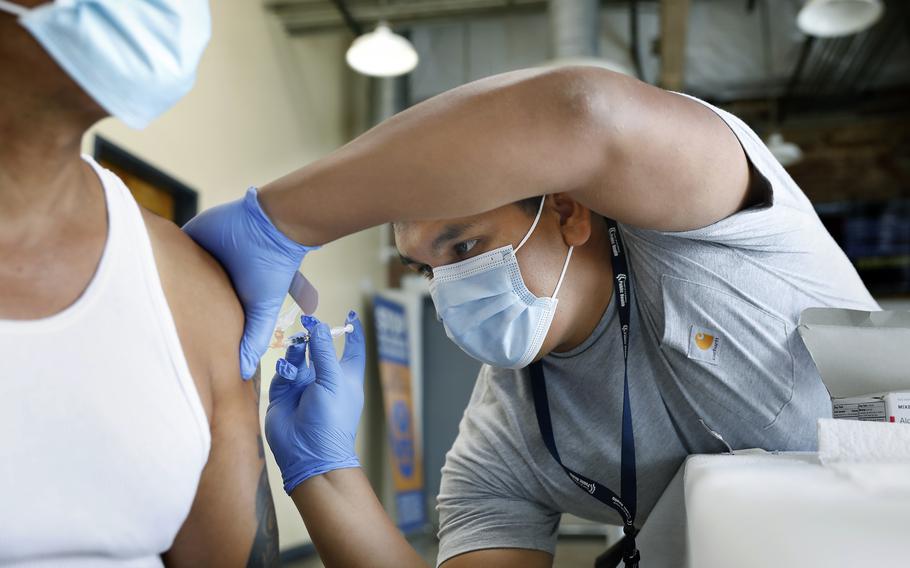
A registered nurse with the Los Angeles Department of Public Health administers a COVID-19 booster at a vaccination clinic at The Village Mental Health Services in Los Angeles, a site run by The People Concern, on Aug 23, 2022. (Christina House, Los Angeles Times/TNS)
(Tribune News Service) — In a recent “Monday Night Football” game, Buffalo Bills safety Damar Hamlin suffered cardiac arrest and collapsed on the field. An immediate response by the trainers, stadium medical staff and the superb intensive care team at the University of Cincinnati Medical Center saved Hamlin’s life. The University of Cincinnati is one of the best places in the U.S. — or the world — for the young man to have been treated.
The episode was a vivid illustration of the contradiction of the American medical system: Our sophisticated emergency treatment is unrivaled even as the comprehensive U.S. patient care system remains the world’s most expensive and possibly the most dysfunctional.
Nowhere has this paradox been more evident than during the COVID-19 pandemic. No country has better care for patients with advanced COVID-19, whose lungs are severely damaged by the coronavirus. But these represent only a fraction of all COVID-19 deaths because most patients die of underlying chronic health conditions or untreatable complications. This is where the U.S. is failing, and, consequently, U.S. mortality and deaths per capita are higher than in most of the world.
What accounts for the high U.S. death rate? A look at the national map is illuminating. The states with the highest deaths per capita are overrepresented in the South — Alabama, Mississippi, Oklahoma, Tennessee and Arkansas — along with West Virginia and Arizona. These states, some of the poorest in the country, are among those with the highest rates of obesity and diabetes and the lowest rates of COVID-19 vaccination. Also of note, West Virginia and Arizona are two states with significantly older populations.
The limited evidence suggests that some combination of age, obesity, diabetes and low vaccination rate, in the setting of poverty, creates conditions for a higher COVID-19 mortality rate. Determining the relative importance of these factors requires performing a statistical technique known as multivariate analysis, and since the beginning of the pandemic, there have been relatively few studies of this type to try to ascertain how much each factor contributes to death from COVID-19. The Centers for Disease Control and Prevention should address this research gap.
The worldwide mortality situation is similar. Countries in Eastern Europe, which along with Peru are the only countries in the world with more deaths per capita than the U.S., are also relatively poor and old. Like the high-COVID-19 states in the U.S., Eastern Europe has high rates of obesity and diabetes and low COVID-19 vaccination rates. Eight in 10 people in some parts of Eastern Europe are obese or pre-obese. Diabetes is 2.6 times more prevalent in Eastern Europe than in Western Europe. And among European countries with the lowest vaccination rates, all are in Eastern Europe.
Without improvements in basic health delivery and infrastructure, no matter how many effective ventilators and other sophisticated equipment the U.S. has, we will have a comparatively high mortality as long as COVID-19 persists. We cannot control our aging population — demography is destiny — but in the short term, we can target this population for vaccination more aggressively.
Our patchwork health care system, in which primary care is often fragmented and insurance-dependent, has done little to address our twin epidemics of obesity and diabetes. There are new breakthrough drugs for both conditions, and those should be made available and affordable for all patients who meet the treatment indications. A national program to encourage lifestyle changes — better diet and more exercise — is essential.
All this may not be enough. Cutting mortality from COVID-19 may require rethinking our long-term approach. The vaccines have been effective and lucrative for the drug manufacturers but have reduced interest and funding for the exploration of other treatments for people who are infected with the virus.
The current strategy of updating vaccines in an attempt to immunize against new variants may fail because viral mutations could occur faster than our ability to keep pace. Our efforts would be better directed toward a universal coronavirus vaccine and new treatments, especially antiviral medications for patients to take in the event of COVID-19 infection. We need a “penicillin miracle” for COVID-19.
Life is a series of contradictions. Hamlin was at once unlucky and lucky. COVID-19 is a disease of the well-fed and affluent and simultaneously a disease of the poor. In that respect, the government and medical community should make a concerted effort to improve the quality of care for the urban and rural poor, as well as for the Indigenous American community, which has been hit hard by the pandemic.
The pandemic is a clarion call for us to make health care more ambitious and more equitable.
Dr. Cory Franklin is a retired intensive care physician.
©2023 Chicago Tribune.
Visit at chicagotribune.com.
Distributed by Tribune Content Agency, LLC.